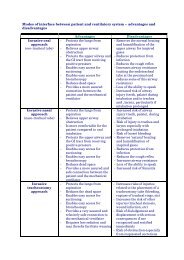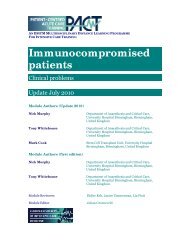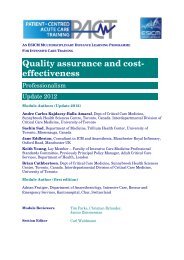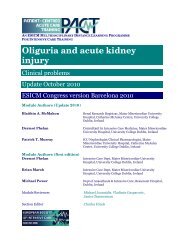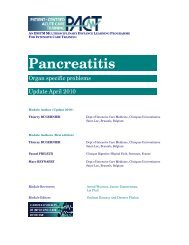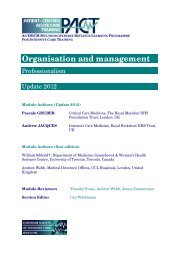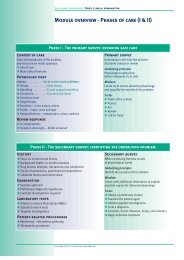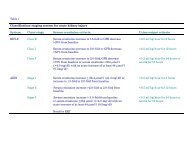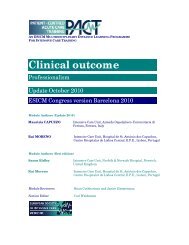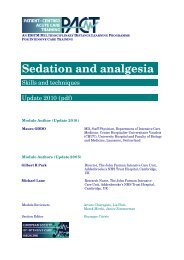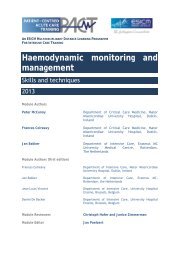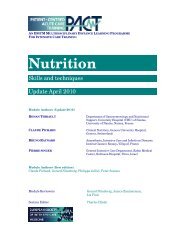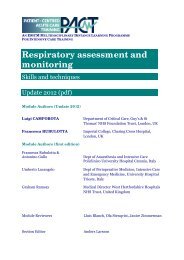Burns injury - PACT - ESICM
Burns injury - PACT - ESICM
Burns injury - PACT - ESICM
You also want an ePaper? Increase the reach of your titles
YUMPU automatically turns print PDFs into web optimized ePapers that Google loves.
Pruitt BA Jr. The diagnosis and treatment of infection in the burn patient.<br />
<strong>Burns</strong> Incl Therm Inj 1984; 11(2); 79–91. PMID 6525539<br />
Greenhalgh DG, Saffle JR, Holmes JH 4th, Gamelli RL, Palmieri TL, Horton JW,<br />
et al. American Burn Association consensus conference to define sepsis<br />
and infection in burns. J Burn Care Res 2007; 28(6): 776–790. PMID<br />
17925660<br />
Chipp E, Milner CS, Blackburn AV. Sepsis in burns: a review of current practice<br />
and future therapies. Ann Plast Surg 2010; 65(2): 228–236. PMID<br />
20606586<br />
Ravat F, Le-Floch R, Vinsonneau C, Ainaud P, Bertin-Maghit M, Carsin H, et al,<br />
Société Française d'Etude et de Traitement des Brûlures (SFETB).<br />
Antibiotics and the burn patient. <strong>Burns</strong> 2011; 37(1): 16–26. PMID<br />
20510518<br />
Metabolic alterations and nutrition<br />
The metabolic response to major burns (>20% TBSA) is characterised by an initial<br />
‘ebb phase’ followed within 24 to 48 hrs by the 'flow phase', i.e. to a hypermetabolic<br />
response.<br />
The metabolic disturbances are qualitatively similar to those of other<br />
critically ill patients (hypermetabolism, increased gluconeogenesis, insulin<br />
resistance, increase in endogenous lipolysis and net loss of the lean body mass) but<br />
are much more intensive and persistent (weeks to months).<br />
The cytokine and mediator release is characterised by the intensity and the<br />
prolonged persistence of the oxidative stress. This response is due to the time<br />
required for burn wounds to heal with the response abating after closure of the<br />
wounds. The increases in stress hormones (catecholamines) are particularly marked.<br />
The body’s response includes an elevation in body temperature, cardiac output and<br />
substrate turnover rate, causing an important increase in energy demand. The<br />
elevation in energy expenditure (EE), is directly related to several factors including<br />
the extent of the burn <strong>injury</strong>, time elapsed since <strong>injury</strong> and the presence of septic<br />
complications. There is an important variation over time in the EE which is difficult<br />
to predict, rendering indirect calorimetric measurements particularly valuable.<br />
Current burn <strong>injury</strong> treatments appear to have attenuated the hypermetabolic<br />
response compared to data from the 1980s. The peak of hypermetabolism lasts from<br />
5 to 21 days after <strong>injury</strong>, and declines progressively thereafter.<br />
Cunningham JJ. Factors contributing to increased energy expenditure in<br />
thermal <strong>injury</strong>: a review of studies employing indirect calorimetry. JPEN<br />
J Parenter Enteral Nutr 1990; 14(6): 649–656. PMID 2273535<br />
29



